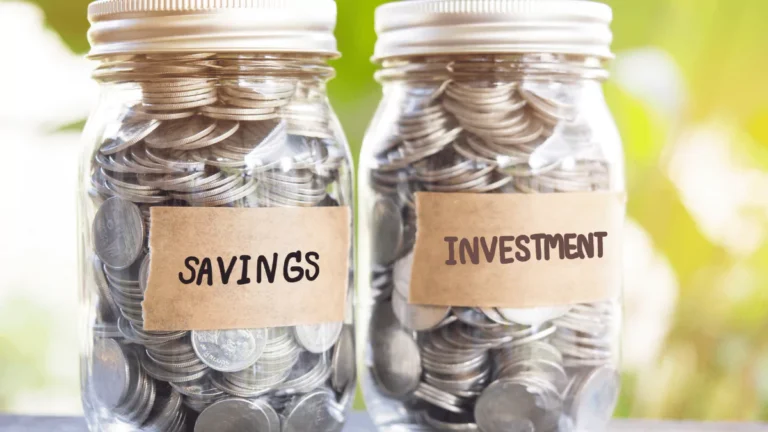People often mix up saving vs. investing — but trust me, they’re two completely different moves when it comes to handling your money. The biggest difference? Risk. Saving usually keeps your money pretty safe, while investing swings open the door to bigger returns, but also bigger risks.
Today, let’s break it down simply: what saving is, what investing is, the good and bad sides of both, and a few real-life examples to make things crystal clear.
What Saving Looks Like
Saving is about putting money aside today so you’re ready for whatever tomorrow throws at you — whether that’s a broken water heater or finally grabbing those concert tickets you’ve been eyeing.
Most people save using high-yield savings accounts or certificates of deposit (CDs), where their money earns a bit of interest over time. It’s a solid move because your cash is usually protected. That said, interest rates can be pretty low, and sometimes they don’t keep up with rising costs in the economy.
Example:
Imagine you want a new laptop that costs $1,000. You plan to buy it in ten months. If you stash away $100 every month into a savings account, you’ll hit your goal, and you won’t have to stress about high-interest credit card debt.
Setting up automatic transfers from your bank account can also make saving effortless. Out of sight, out of mind — but still growing.
Pros and Cons of Saving
While saving is a must, it’s smart to pair it with investments once you’re ready, so your money doesn’t just sit there gathering dust.
What Investing Looks Like
Investing is where things get a little more exciting — and a little more risky. Here, you put your money into things like stocks, bonds, mutual funds, or real estate, hoping it’ll grow over time.
The catch? Nothing’s guaranteed. Markets can go up, down, or sideways. But if you’re aiming for big dreams — a comfortable retirement, buying a home, paying for college — investing is often the better path.
The longer you can leave your investments untouched, the better your chances are of riding out the market’s ups and downs. And the bigger the rewards could be.
Example:
One great example is a 401(k) retirement plan. You invest a piece of your paycheck into a mix of bonds, stocks, and other assets. Your employer might even kick in some extra money as a match (free money, who wouldn’t want that?).
Plus, the money in a 401(k) grows tax-deferred, meaning you won’t pay taxes on it until you start taking it out later. If you’re using a Roth 401(k), you pay taxes upfront and pull the money out tax-free later.
Starting early with something like a 401(k) can be a game-changer. Thanks to the compounding returns, even small contributions can snowball into serious cash over time.
Pros and Cons of Investing
When Should You Save, and When Should You Invest?
This all boils down to what you need and when you need it.
If you’re working toward something soon, like buying a new phone or saving for a wedding, stick to saving. Your money will be there when you need it, with little chance of losses.
If you’re thinking long term — like funding your kid’s college or building a retirement nest egg — investing makes sense. You’ve got time to ride out any rough patches and let your money work harder.
Saving vs. Investing: Which One’s Riskier?
Saving comes with almost no risk if you stick with reputable banks. Investing, on the other hand, always brings some uncertainty. You might make a lot, but you could also lose some (or even most) of it if you aren’t careful.
Why Some People Stick to Saving
There are a bunch of reasons people prefer saving over investing:
- They feel more comfortable having money easily available for emergencies.
- They’re working toward short-term goals and can’t risk any loss.
- They don’t have enough extra cash yet to invest.
- They aren’t comfortable with investing risks or simply aren’t sure where to start.
And that’s totally fine. Saving is better than doing nothing.
How Much Should You Save vs. Invest?
It depends on your goals and objectives, how much risk you can handle, and where you are in life. A classic rule of thumb:
- Save enough for emergencies and short-term needs first.
- After that, if you’re free of high-interest debt, start investing whatever you can.
Everyone’s balance will look a little different, and that’s okay. It’s not a one-size-fits-all situation.
Why Investing Can Feel Intimidating
A lot of people struggle with investing simply because it feels complicated. Fear, lack of experience, or bad past experiences can all make people hesitant. Plus, watching markets swing wildly can scare even seasoned investors.
Building wealth through investing takes time, patience, and the ability to stay calm when things get shaky. It’s more like planting a tree than playing the lottery — the payoff comes later.
Wrapping It Up
Saving and investing are two powerful ways to take control of your financial future — and you really don’t have to pick just one. Saving gives you security and peace of mind. Investing gives you a shot at building real wealth.
Finding the right mix for your life can protect you against surprises, help you hit your dreams, and set you up for a future that’s not just okay but great.
Start small if you need to — just start.
Michael Adams is a professional finance writer with a focus on tax education, budgeting, and personal finance. His goal is to make income tax topics clear and practical for individuals and entrepreneurs.

